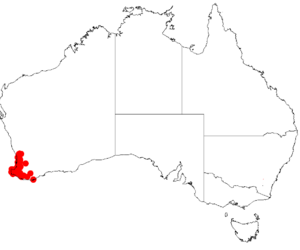Acacia lateriticola facts for kids
Quick facts for kids Acacia lateriticola |
|
|---|---|
| Scientific classification | |
| Genus: |
Acacia
|
| Species: |
lateriticola
|
 |
|
| Occurrence data from AVH | |
Acacia lateriticola is a type of shrub, a small woody plant. It belongs to the Acacia family, which is also known as wattles. This particular acacia grows only in a specific part of southwestern Australia. When a plant grows only in one area, it is called endemic.
What Does It Look Like?
This shrub has leaves that look a bit like ferns. It usually grows to be about 0.4 to 1.5 meters (1.3 to 5 feet) tall. Its small branches are covered in tiny hairs.
Its leaves are made up of two main parts, called pinnae. The pinnae closer to the stem are 2 to 6 millimeters long. The pinnae further away are 6 to 20 millimeters long.
Each of these pinnae is made of even smaller leaf parts called pinnules. The closer pinnae have one to three pairs of pinnules. The further pinnae have two to six pairs of pinnules.
These small, flat pinnules are green and shaped like an oblong or a spearhead. They are 4 to 15 millimeters long and 1.5 to 3 millimeters wide.
The plant blooms from May to October, showing off yellow flowers. Its simple flower clusters, called inflorescences, grow alone or in pairs where the leaves meet the stem (the axils).
These flower-heads are round, about 7 to 10 millimeters across. Each one has 24 to 36 light golden or sometimes cream-colored flowers.
After the flowers, seed pods form. These pods are firm and narrow, about 3 to 5 centimeters long and 7 to 11 millimeters wide. They have thick edges.
How Was It Named?
A botanist, which is a scientist who studies plants, named Bruce Maslin first officially described this species in 1975. He wrote about it in a scientific paper called Studies in the genus Acacia (Mimosaceae) - A Revision of Series Pulchellae. This paper was published in the journal Nuytsia.
Later, in 2003, another botanist named Leslie Pedley reclassified it. He moved it to a different group called Racosperma lateriticola. But in 2006, it was moved back to the Acacia group.
Where Does It Grow?
This plant naturally grows in the Peel and South West regions of Western Australia. It is often found growing in lateritic soils, which are reddish soils rich in iron and aluminum.
Most of these plants grow from around Chittering in the north, stretching to Manjimup in the east, and down to Dunsborough in the south. It often grows as part of the Eucalyptus marginata and Corymbia calophylla woodland and forest areas.

